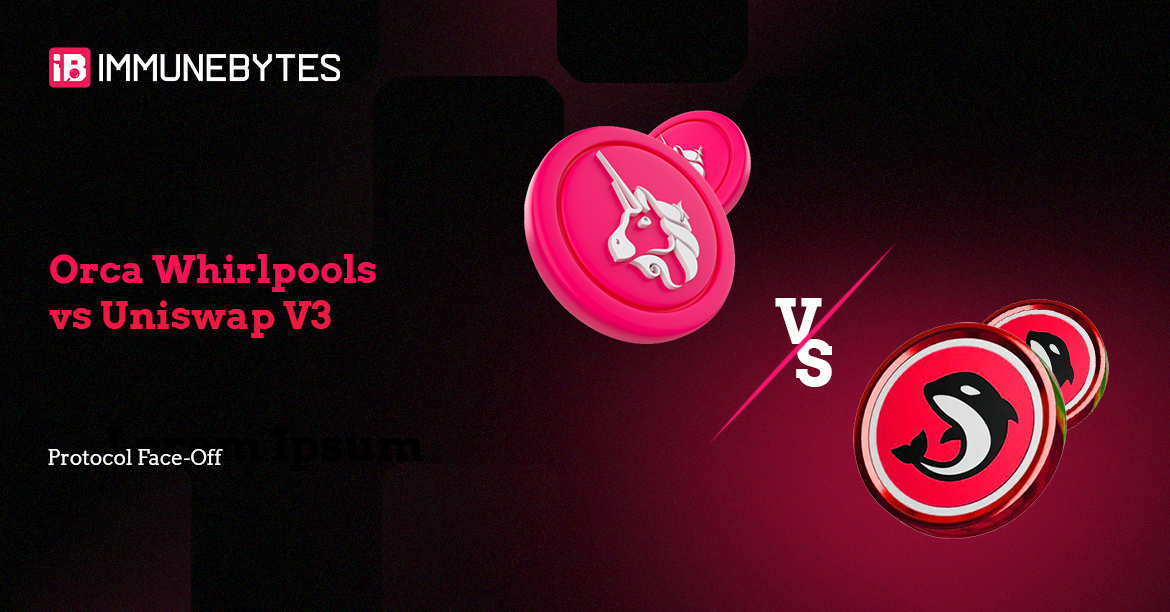Decentralized exchanges (DEXs) are crucial pillars of the DeFi ecosystem. Two standout DEXs in recent times are Orca Whirlpools on Solana and Uniswap V3 on Ethereum. Both implement sophisticated liquidity mechanisms but differ fundamentally in design, technicalities, and operation. Here we deeply examine their underlying logic, technical details, features, and potential drawbacks without bias toward either platform.
Underlying Liquidity Logic
Orca Whirlpools adopts the Concentrated Liquidity Market Maker (CLMM) model, inspired by Uniswap V3 itself. Liquidity providers (LPs) select specific price ranges (ticks) to allocate liquidity, enhancing capital efficiency. Whirlpools employ Solana’s fast and inexpensive blockchain infrastructure to allow LPs frequent and cost-effective re-ranges, essential for reacting to market volatility.
Uniswap V3 pioneered concentrated liquidity on Ethereum, allowing LPs significant flexibility to provide liquidity within customized price ranges. This improvement offered tremendous capital efficiency compared to the previous Uniswap V2 version, with LPs able to adjust ranges according to market dynamics.
Technical Architecture and Details
Uniswap V3:
- Developed in Solidity, focusing extensively on gas optimization to handle Ethereum’s cost-heavy transaction environment.
- Implements a per-pool smart contract pattern with a dedicated pool factory, including built-in, on-chain Time-Weighted Average Price (TWAP) oracles.
- LP positions are minted as ERC-721 NFTs, providing rich interoperability within Ethereum’s broader NFT ecosystem.
Orca Whirlpools:
- Built in Rust, leveraging a highly optimized custom 256-bit math library specifically tailored for Solana’s compute limitations.
- Uses Program Derived Addresses (PDAs), which generate deterministic pool addresses, removing dependence on centralized administration.
- Liquidity positions are represented by NFTs minted as Solana SPL tokens, enhancing integration and ease of use.
Fee Structures & Protocol Fees
Uniswap V3
- V2: 0.3% swap fee, all to LPs.
- V3: pools have variable fee tiers. Protocol fee switch can redirect a portion to Uniswap governance.
- Fees accumulate in the pool, claimed via LP position burn.
Orca Whirlpools
- Similar tiers: 0.3% for volatile, 0.01–0.05% for stable pairs.
- Protocol fees can be set aside for the DAO treasury.
- Whirlpools use “global fee growth” and “position fee growth” for precise calculation, like Uniswap V3’s fee growth per liquidity unit.
- On Solana, fee collection happens as a separate PDA transfer, risk of lost fees if state updates break.
Routing & Aggregation: Self vs. Ecosystem
Uniswap V3
- Router logic is fully contained, swapExactTokensForTokens or multihop.
- No native cross-DEX aggregation; relies on external aggregators like 1inch.
Orca Whirlpools
- The router is simple for Orca-only swaps.
- Real power comes when used with Jupiter (Solana’s aggregator) that splits orders across Orca, Raydium, Phoenix, Lifinity, etc.
- Jupiter uses smart routing: price impact modeling, simulated routes, runtime split across multiple pools in one tx.
State Management & Upgradability
Uniswap V3
- Each pool is immutable. Logic bugs mean permanent loss or migration to a new pool.
- LP positions are ERC-20 tokens (V2) or NFTs (V3).
- Governance controls fee switch but cannot upgrade pools.
Orca Whirlpools
- Whirlpools logic is in immutable on-chain programs once upgrade authority is revoked.
- LP positions are Solana PDAs + tokenized NFTs (like Metaplex standard).
- Solana’s rent-exempt storage: every position must maintain minimum lamports or risk closure.
Composability & Integration
Uniswap V3
- Plugged into everything: lending, synthetic assets, vaults.
- A single source of truth for DeFi pricing.
- Flash swaps: lets arbitrage bots balance pools with no upfront capital.
Orca Whirlpools
- Native to Solana.
- Used mostly by Jupiter for routing.
- Not as widely integrated in lending protocols yet because Solana’s lending ecosystem is smaller.
Math Libraries & Gas vs. Compute
Uniswap V3
- Gas constraints shape the code → heavy math optimized with fixed point.
- High gas fees protect pools from spam attacks.
Orca Whirlpools
- Solana’s compute budget is fixed per transaction.
- Cross-Program Invocations cost compute units — too many can hit the limit.
- Whirlpools math written in Rust, often verified with similar unit tests as Uniswap’s V3 code.
Protocol-Level Snapshot
| Aspect | Uniswap V3 | Orca Whirlpools |
| AMM Core | Constant Product (V2), Concentrated (V3) | Constant Product, Whirlpools (V3-like) |
| Position State | ERC-20 or NFT | PDA accounts + tokenized NFT |
| Tick Management | Sqrt(P) ticks, Bitmaps | Same sqrt(P) ticks, PDA storage |
| Routing | Self-contained, no built-in aggregation | Best with Jupiter aggregator |
| Execution Cost | High gas on L1, better on L2s | Ultra low fees, fast finality |
| Composability | Top-tier, industry standard | Solana-native, mostly routed via Jupiter |
| Security Pitfalls | EVM-specific (reentrancy, approvals) | PDA seed design, rent, CPI misuse |
| Capital Efficiency | Excellent but costly to maintain | Same, but practical for smaller LPs |
| Upgradability | None (immutable pools) | Upgradable until authority revoked |
| Flash Swaps | Native (arbitrage) | None — atomic Solana TX replaces some needs |
Key Features and Functionalities
| Feature | Orca Whirlpools (Solana) | Uniswap V3 (Ethereum) |
| Concentrated Liquidity | Adjustable price ranges | Adjustable and customizable price ranges |
| Transaction Costs | Extremely low-cost swaps (<$0.01) | Higher gas fees (~100k-200k gas per swap) |
| Speed | Sub-second transactions | Slower block times (12-15 seconds per block) |
| Fee Tiers | Typically between 0.01%-0.3% | Fixed fee tiers: 0.05%, 0.3%, 1% |
| Oracles | Integrated tick-based TWAP stats | Built-in on-chain TWAP oracles |
| Governance | ORCA token governance | UNI token governance, community-driven |
Drawbacks and Tradeoffs
Orca Whirlpools:
- Pros: Very fast transactions, extremely low cost, high efficiency for dynamic LPs, and minimal administrative intervention.
- Cons: Solana ecosystem fragmentation, complex tick management, and LPs must actively manage positions due to high market volatility and impermanent loss risk.
Uniswap V3:
- Pros: Rich Ethereum ecosystem, robust tooling, sophisticated governance mechanism, and established oracle solutions.
- Cons: High transaction fees (gas costs), slower response times to market shifts, and LP range management complexities and costs.
Ecosystem Considerations
Orca Whirlpools have rapidly grown to prominence on Solana, integrating seamlessly with Jupiter aggregator and other Solana-native DeFi tools. Their lightweight design capitalizes on Solana’s speed and low-cost structure.
Uniswap V3 maintains its dominant position in the Ethereum and L2 ecosystem, facilitating substantial volumes across multiple Ethereum-compatible networks. Its mature tooling and developer-friendly documentation continue to attract significant institutional and retail liquidity.
System-Level Differences
- Blockchain Design: Solana’s sub-second transaction times significantly favor Orca’s strategy of frequent adjustments, whereas Ethereum’s higher gas fees encourage a more static liquidity provision.
- Math Precision: Orca designed a specialized 256-bit math library tailored to Solana’s compute limits, whereas Uniswap V3 relies on Solidity’s established arithmetic libraries, optimizing within Ethereum’s gas constraints.
Conclusion
Both Orca Whirlpools and Uniswap V3 represent advanced, capital-efficient liquidity solutions tailored specifically for their respective blockchain environments. Orca thrives in Solana’s fast, low-cost environment, providing unparalleled speed and flexibility. Uniswap V3 excels in Ethereum’s robust, diverse ecosystem, providing stability, sophisticated tooling, and extensive interoperability.
Ultimately, choosing between Orca Whirlpools and Uniswap V3 is not about superiority but about alignment with specific user needs, preferences, and the blockchain ecosystem they prefer.

